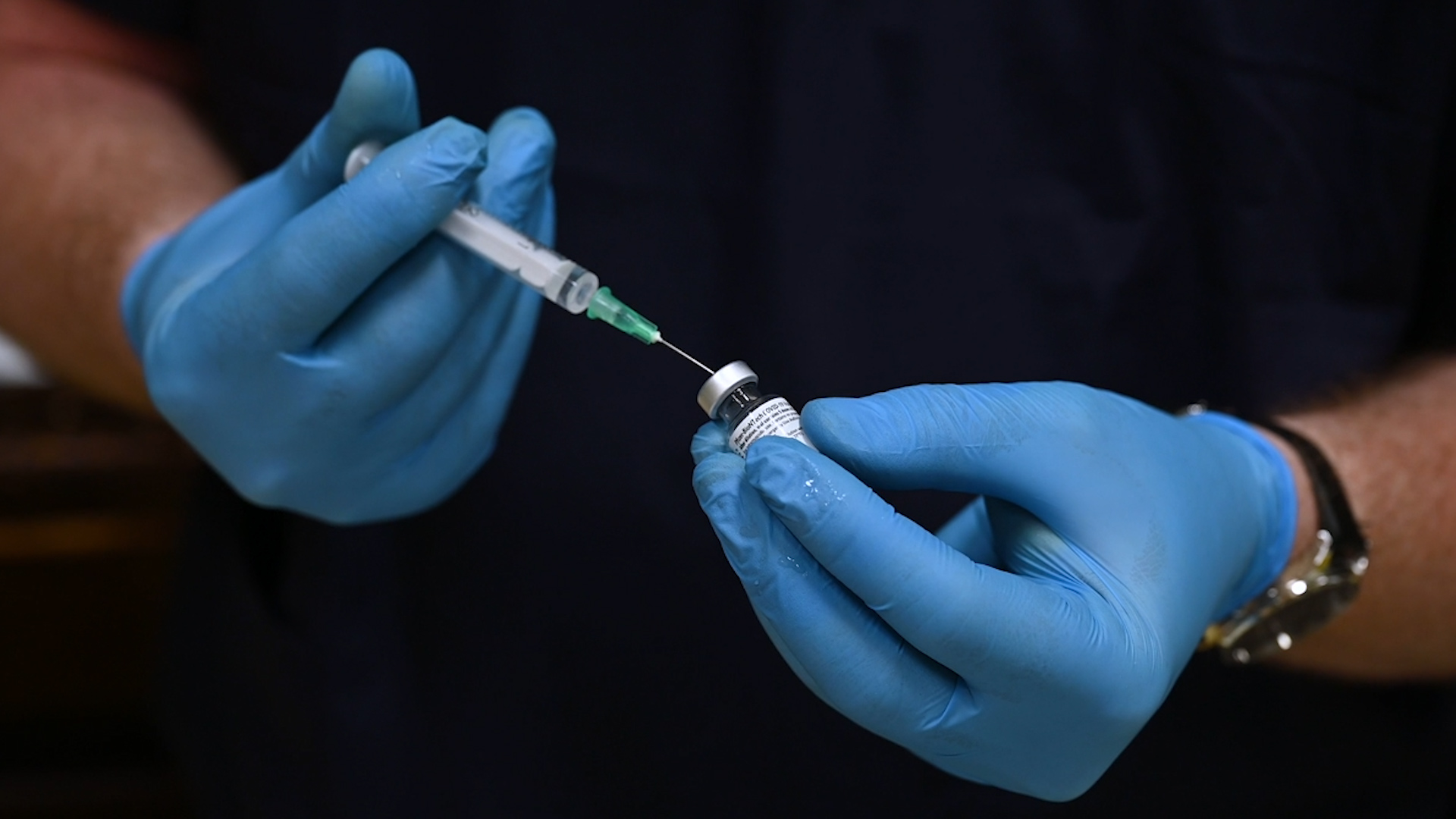For the second week in a row, Massachusetts health officials revealed that fewer communities are at the highest risk of coronavirus transmission than the week before.
Thursday's town-by-town coronavirus risk data -- which classifies communities' risk level on a scale from red, the highest, to grey -- puts 192 cities and towns in the red zone, from 222 last week. There were 229 the week before that, just shy of two-thirds of all the state's communities. (See this week's full list of red zone communities below.)
Massachusetts' coronavirus metrics have been trending down lately, seeming to signal that the state's second surge is abating. The drop in communities in the red zone may be another sign of the surge receding.
Get Boston local news, weather forecasts, lifestyle and entertainment stories to your inbox. Sign up for NBC Boston’s newsletters.
The Department of Public Health also released its weekly vaccine dashboard Thursday, which showed that nearly half a million doses have been given to people in the Bay State, while the pace of vaccinations is rising as well.
There have been frustrations over the rollout of vaccines in Massachusetts, with Wednesday’s rollout online of a sign-up site for Massachusetts residents age 75 and older to make an appointment not a smooth experience for all.
Gov. Charlie Baker announced Thursday that more than 35,000 new COVID-19 vaccination appointments would go live later in the day at sites across Massachusetts, but added that many of them have already been booked.
See Thursday's weekly vaccine report here and the town-by-town coronavirus data here.
Massachusetts COVID Hot Spots
The following 192 communities are in the highest risk level as of Thursday: Abington, Acushnet, Adams, Agawam, Ashburnham, Attleboro, Auburn, Avon, Ayer, Barnstable, Barre, Belchertown, Bellingham, Berkley, Berlin, Billerica, Blackstone, Boxford, Boylston, Braintree, Brewster, Bridgewater, Brockton, Burlington, Canton, Carver, Chatham, Chelmsford, Chelsea, Chicopee, Clinton, Cohasset, Dalton, Dartmouth, Dedham, Dennis, Dighton, Douglas, Dover, Dracut, Dudley, Duxbury, East Bridgewater, East Longmeadow, Easton, Edgartown, Everett, Fairhaven, Fall River, Falmouth, Fitchburg, Foxborough, Framingham, Franklin, Freetown, Gardner, Georgetown, Gloucester, Grafton, Granby, Great Barrington, Groveland, Hadley, Halifax, Hamilton, Hampden, Hanover, Hanson, Harwich, Haverhill, Holbrook, Holden, Holyoke, Hopedale, Hudson, Hull, Ipswich, Kingston, Lakeville, Lancaster, Lawrence, Lee, Leicester, Leominster, Littleton, Lowell, Ludlow, Lunenburg, Lynn, Malden, Manchester, Mansfield, Marion, Marlborough, Marshfield, Mashpee, Mattapoisett, Maynard, Medway, Merrimac, Methuen, Middleborough, Middleton, Milford, Millbury, Millis, Monson, Nahant, Nantucket, New Bedford, Newbury, North Attleborough, North Brookfield, Norton, Norwood, Oak Bluffs, Orange, Orleans, Oxford, Palmer, Paxton, Peabody, Pembroke, Pepperell, Plainville, Plymouth, Plympton, Quincy, Randolph, Raynham, Rehoboth, Revere, Rochester, Rockland, Rockport, Rowley, Rutland, Salem, Salisbury, Sandwich, Saugus, Scituate, Seekonk, Sharon, Shirley, Shrewsbury, Somerset, Southampton, Southborough, Southbridge, Southwick, Spencer, Springfield, Sterling, Stoughton, Sturbridge, Sutton, Swansea, Taunton, Templeton, Tewksbury, Tisbury, Topsfield, Townsend, Tyngsborough, Upton, Uxbridge, Wakefield, Walpole, Waltham, Ware, Wareham, Warren, Webster, West Boylston, West Bridgewater, West Brookfield, West Springfield, Westfield, Westford, Westminster, Westport, Weymouth, Whitman, Wilbraham, Wilmington, Winchendon, Winthrop, Woburn, Worcester, Wrentham and Yarmouth.
Of those communities, two are newly in red on the list this week: Orleans and Sharon.
And 32 communities dropped out of red: Amesbury, Andover, Ashby, Ashland, Athol, Beverly, Boston, Bourne Boxborough, Brimfield, Brookfield, Charlton, Danvers, Deerfield, East Brookfield, Hatfield, Holliston, Lynnfield, Medford, Norfolk, North Andover, North Reading, Norwell, Pittsfield, Reading, Stoneham, Stow, Sunderland, Swampscott, Wenham, West Newbury and Westwood.
To qualify for the red, high-risk category under the new metrics, communities with populations under 10,000 must have more than 25 cases. For mid-size communities of between 10,000 and 50,000 people, they must have an average of more than 10 cases per 100,000 people and a positive test rate of more than 5%. And for larger communities of greater than 50,000 people, they must have more than 10 cases per 100,000 people and a positive test rate of more than 4%.
Having trouble getting a coronavirus vaccine in Massachusetts? Submit a tip to our investigators here.
Previously, the state used the number of cases detected on average each day over two weeks to determine if Massachusetts' communities are at high risk for coronavirus transmission. The new list factors in population size and positive test rate.
Read this week's full report here, with data on communities' percent positivity, county- and state-level data and more.
The Department of Public Health is no longer including a map of the community-level risk in the weekly report. An official told NBC10 Boston that the map is no longer seen as being as helpful as it once was, now that coronavirus cases are being reported in most communities.
Mass. Vaccine Data
This week's vaccine report from the Department of Public Health shows that Massachusetts vaccinators were able to distribute 111,901 doses were given this week, for a total of 496,103 doses given out so far.
That doesn't mean half a million people have been vaccinated -- the two coronavirus vaccines approved so far in the country's fight against the pandemic, from Pfizer and Cambridge-based Moderna, both require that people receive two doses, which are recommended to be spaced out over three or four weeks.
But the pace that vaccines are being administered is rising. This week's report was the first to show that more than 100,000 doses were given out in a week. The prior two weeks' reports, for example, showed roughly 85,000 doses given.
A total of 107,525 vaccine doses were shipped to Massachusetts between last Wednesday and this Tuesday, according to the report. That's down 7% week over week.
Vaccines are the key to getting society back to normal, since they have been found to offer the greatest protection from serious complications in people who are infected with the virus. The widespread distribution of the vaccines will trigger the final phase in Massachusetts' reopening plan, when restrictions will be lifted.
Vaccinations began in Massachusetts last month. See the Baker administration's plan for rolling out the vaccine here.
Changes to Massachusetts' Hot Spot Data
The weekly report has a history of somewhat abrupt changes.
When Massachusetts health officials first unveiled a digital coronavirus dashboard in early January, they stopped releasing town-by-town coronavirus metrics on a weekly basis, since they are included in the "city and town" tab of the interactive dashboard. It shows communities' positive test rate and overall testing rate, though not other metrics that were included in the old format.
"Data previously found in this report, including town-by-town cases and testing reporting, can now be found in the daily interactive dashboard," a note in that week's pared-down weekly report said. But a new version of the report was issued later that night brought back the data.
More major changes before that knocked the number of communities in the red zone from 121 to 16 as what was defined a high-risk community changed. Officials said the adjustment brought Massachusetts more in line with risk levels in other states.
However, the numbers grew again as the weeks passed, eventually rising to 190 communities in the red zone before the data switched to the interactive dashboard.
That week's report also dropped the map that displayed the town-by-town coronavirus data. It showed where in the state communities were at high, moderate or low risk of transmission, but officials said it was no longer very informative.
In the weeks before that, officials added information on COVID-19 clusters, both on where major clusters have been identified -- they're listed in the report with an asterisk -- and on trends among clusters.
The color-coded town-by-town data was introduced in August, and the Baker administration announced that the state would focus its strongest COVID-mitigation efforts on towns in the red category. Communities can only move to Step 2 of Phase 3 of Massachusetts' reopening plan, announced in late September, if they are not consistently in the red.
Before the introduction of that data, the standard for measuring hot spots had been the positive COVID test rate over the preceding 14 days. The Department of Public Health's weekly report still includes that information, along with other metrics like how many tests are being conducted locally and how many cases have been reported locally.
Some of Massachusetts' smaller towns had taken issue with having their risk assessed based on cases per capita alone. They said that, when a town only had a few thousand people, an outbreak in just one household could send it into red under the criteria at the time: 8 cases of COVID-19 per 100,000 residents.



